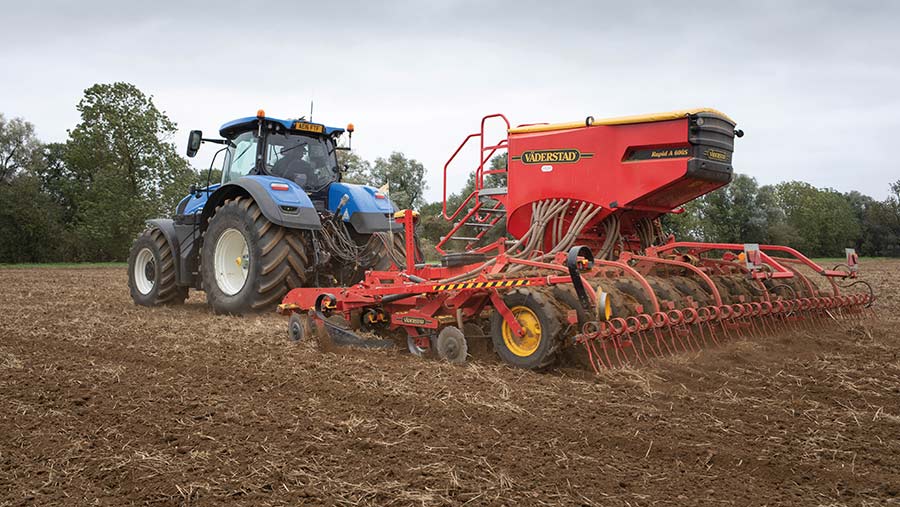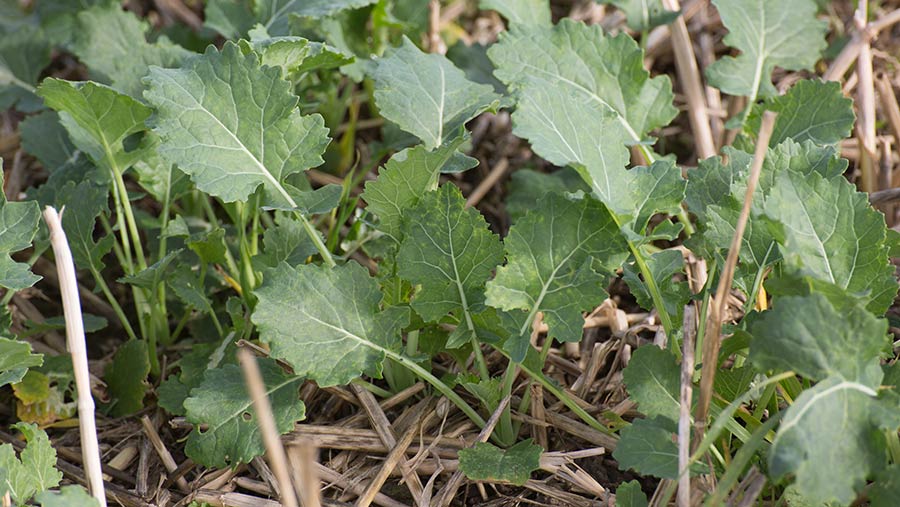Crop Watch: BYDV warning as cereal drilling starts early
 © Tim Scrivener
© Tim Scrivener After two wet autumns, the cereal drilling season has got off to an early start and there are concerns over the implications for blackgrass control and the barley yellow dwarf virus risk – especially as aphid numbers are already high.
In oilseed rape, crops are variable and some later-drilled crops are likely to get written off after the flea beetle onslaught.
See also: Advice on clamping sugar beet for optimal harvest storage
East
Ben Pledger
Farmacy (Bedfordshire/Hertfordshire)
Cereal drilling has started in the region with growers deciding to make use of dry conditions and relatively good seed-beds to get crops established in good conditions.
There is the usual talk about increased risk of barley yellow dwarf virus and delaying drilling in the fight against blackgrass, however it is understandable that after the last two wet autumns there is the temptation to go earlier than we really should to ensure getting autumn drilling done in good conditions.
If this is the case, categorise fields into low, medium and high blackgrass pressure, and start by drilling the lower pressure fields first.
Flufenacet will again form the cornerstone of pre-emergence herbicide treatments, and depending on cropping and field history, it will be partnered with either diflufenican, pendimethalin or aclonifen, with the addition of tri-allate where greater control is desired. Whichever chemistry is used, attention will be paid to application to get the best control from this operation.
Aphid monitoring
Barley yellow dwarf virus can cause significant yield loss in cereals, so monitoring of crops this autumn is necessary to identify aphid flights into individual fields. Pyrethroid insecticides are the main control for option outside of tolerant varieties, pay attention to buffer zones as all products are not the same.
Remember tolerant varieties are not resistant and can act as a source of virus, so may benefit from a single insecticide treatment.
Oilseed rape this year is variable once again. Crops drilled prior to mid-August straight into stubbles look well where moisture has been conserved.
Nutrition has aided establishment massively, especially from chicken manure and digestate, where there is noticeably less flea beetle damage. I’m putting this down to the smell putting the flea beetle off.
Later drilled crops have struggled to get going, and were smaller when the flea beetle turned up in force just after the August bank holiday. I expect more of these later drilled crops will be written off in the next few weeks unless a miraculous turnaround occurs
North
David Martindale
Arable Alliance (Yorkshire)
Good conditions in the second half of September have allowed rapid progress to be made with cereal drilling despite some experiencing delays to seed deliveries. Cultivations and final seed-beds have been going very well.
With harvest finishing earlier this year compared with 2020 there seems to be more urgency to drill as soon as possible. The last two autumns have been difficult so many have pushed on and have already sown significant areas.
Oilseed rape crops are establishing well with a huge range of growth stages from cotyledon to eight true leaves. The early to mid-August drilled crops largely escaped the feeding damage from cabbage stem flea beetle. Several later-sown crops have suffered some niggling flea beetle damage, but nothing to cause crop destruction yet.
Levels of feeding damage from flea beetle has been variable even on the same farm, with proximity to last year’s oilseed rape, organic manures and cultivation strategy all influencing factors.
Thankfully, there has been enough moisture and warm temperatures to allow crops to grow away from this pest. Now it is a waiting game to see what effect the flea beetle larvae will have in the coming months.
Slugs have been very active in emerging oilseed rape crops and arguably have been more of a higher risk of crop failure than flea beetle.
Blackgrass emergence in earlier sown crops of oilseed rape has been protracted, with some at the one leaf stage while others are tillering. This has made the timing of the contact-acting herbicide clethodim difficult, as ideally the earlier blackgrass should not become too advanced before spraying. Yet we are still wanting to wait and catch the later-emerging plants.
Large flushes of weeds such as cranesbill, cleavers and poppy are being controlled by halauxifen-methyl plus picloram while they are still small.
Cereal emergence
Mid-September sown crops of winter wheat and barley have emerged well so far. Pre-emergence herbicides have been applied for blackgrass, ryegrass and sterile brome control. Unfortunately persistent periods of strong winds and warm temperatures have meant that while the cereals have been sown into moisture the soil surface has been very dry, which could affect residual herbicide performance.
Peri-emergence herbicides are also being applied in some situations. Again there has been the issue of dry seed-bed surfaces so there is concern that these residual herbicides, which form the backbone of grassweed control in cereals, will not perform as well as hoped. These conditions, combined with earlier sowings, may need to be remembered next June when assessing herbicide performance.
Aphids have been easy to find on volunteer cereals in oilseed rape. For the early-sown winter wheat and barley crops be on the lookout for aphids. This is a pest which does not require controlling at the first sightings, but rather, the second wingless generation which are the primary vectors for spreading barley yellow dwarf virus.
Gout fly can also be problematic on early-sown crops. While the flies themselves are difficult to see in the field, it is best to monitor the small, white cigar-shaped eggs on the leaf surface and decide whether an insecticide is required before the larvae enter the plant.
Significant damage from gout fly is quite rare, with the crop often able to compensate for damaged tillers.
West
Neil Potts
Matford Arable (Devon)
Normally at this time in September there would be very little to report on, other than the progress of the small area of oilseed rape that gets planted in the area.
First though, a quick assessment of the harvest in the region. The winter barleys were on the whole pretty good, with yields coming in at average to above average levels, although those crops that suffered from delayed harvest were down a bit on expectations. The winter oat yields again were pretty solid.
The wheat crop is where the variability has crept in, with some crops performing extremely well and others being disappointing. Having talked it over with my colleagues, the poor performance in general seems to be related to poor septoria control, and where things appear to have gone wrong was very early in the season with either late-applied or not-applied T0. A very wet May (up to 250mm rain in some parts) then put the crop under extreme disease pressure.
After two wet autumns where growers have been caught out and not been able to drill, or have planted into less than ideal seed-beds, an early start has been made to drilling this year. At time of writing I have both barley and wheat crops on the cusp of emerging. The most immediate and obvious threat to these crops is going to be from barley yellow dwarf virus.
Aphids
There are large numbers of aphids about in other crops so it is fair to assume that after quite a long spell of aphid favourable weather, that we are going to be facing some fierce pressure from this very damaging virus. These crops will require a minimum of three applications to keep on top of the problem.
The very early drilling is almost certain to bring with it higher risks of lodging and foliar diseases as we progress through the 2021/2022 growing season.
The maize crop in many places is now very close to harvest and with ground conditions still good, this, hopefully, will mean that wheat crops planned for after these crops will be planted on time and into good seed-beds.
The few crops of oilseed rape that have gone in have by and large established well despite the attention of both slugs and flea beetle. It will be another week or two before the picture becomes totally clear on this crop, as there has been some delayed emergence due to dry conditions in some fields.
South
Tod Hunnisett
AICC (Sussex)
Welcome to my first Cropwatch of the new season. It would be nice one year to be able to say this without the feeling that I want to say “Good riddance” to the last season. Difficult harvest, disappointing yields and an influx of late weeds all make us want to move on to next year. Problems with glyphosate and fertiliser haven’t helped. I remember when getting nitrogen sorted used to be a Christmas job.
Drilling will have begun in earnest by the time you read this. Hopefully, we’ll have had a bit of rain to help the pre-emergence herbicides work properly. We haven’t had much opportunity to get a grassweed chit this year, with the late harvest and not much rain. Once again, the importance of consolidating moved soil has shown itself this year. Fields that have been moved and then Cambridge rolled are considerably greener than those that have just been tickled about.
Aphid alerts
Reports are coming in of high levels of aphids in various parts of the country. Where people have drilled early this will need to be monitored. Then we’ll have the annual conflict of deciding how many insecticides are needed, and whether they’re actually doing anything in the light of increased resistance. What would I give for the return of neonic seed treatments?
Early drilled oilseed rape seems to have escaped the worst ravages of flea beetle. Mid-drilled were attacked quite badly, but seem to be growing away from it now. Some late drilled crops have failed completely due to lack of rain.

The debate about late versus early drilling will go on for ever, but all I can say is that my highest yielding OSR crop this year was drilled on 2 August. If I have a crop that’s worryingly forward at Christmas time, for me that is quite a nice problem to have.

